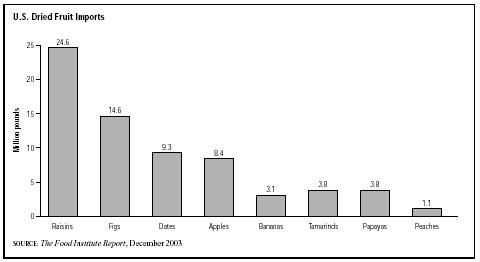SIC 2034
DRIED AND DEHYDRATED FRUITS, VEGETABLES, AND SOUP MIXES
This category covers establishments primarily engaged in sun drying or artificially dehydrating fruits and vegetables, or in manufacturing packaged soup mixes from dehydrated ingredients. Establishments primarily engaged in the grading and marketing of farm dried fruits, such as prunes and raisins, are classified in SIC 5149: Groceries and Related Products, Not Elsewhere Classified.
NAICS Code(s)
311423 (Dried and Dehydrated Food Manufacturing)
311211 (Flour Milling)
Dried and dehydrated fruits, vegetables, and soups generate an annual shipment value of more than $3 billion, according to the most recent figures published by the U.S. Census Bureau. Dried and dehydrated fruits and vegetables make up nearly two-thirds of this total, while soup mixes accounted for the remaining one-third. While the most popular dried products have typically been raisins and prunes, the increasing popularity of other dried fruits brought products such as dried apples and dates into the spotlight in the early 2000s. In fact, while imports of raisins declined nearly 9 percent in 2003 to 24.5 million pounds, imports of dried apples grew 43 percent to 8.4 million pounds, and imports of dates grew 41 percent to 9.3 million pounds.
Sun drying, one of the oldest known methods of fruit preservation, originated thousands of years ago. Dehydration preserved foods by removing the moisture that microorganisms needed to thrive. Although the technique remained in use in the 1990s, mechanical drying methods increased beginning in the late nineteenth century. Besides preservation, reduction in bulk and weight were considerations in the drying of fruits and vegetables.
As consumer interest in healthy eating continued to rise during the 1990s, processors of dates, raisins, dried apricots, apples, cherries, and other fruits promoted

their products as nutritious snacks, as well as ingredients for home baking and cooking. Processors used dried fruits in a wide variety of food products. Dates—popular with retail shoppers—lent texture, flavor, and sweetness to processed cereals, baked goods, snack bars, and frozen desserts. Along with dates, raisins enjoyed a variety of uses in food processing. Products introduced in the 1990s included donuts with raisins, fat-free raisin cookies and fruit bars, and even raisin salami. Dried cranberries were also gaining popularity among American consumers.
The industry also witnessed the introduction of sophisticated processing technology, such as quality-monitoring computer programs and lasers. New dehydration processes, such as a three-stage vegetable dehydrator employed by Breedlove Dehydration Foods of Lubbock, Texas, were used to save surplus food for later distribution to a national network of food banks to feed the homeless.
Roughly 150 establishments, most of which are located in California or Idaho, make up this industry. Two strong performers are Dole Food Company Inc. and Blue Diamond Growers, both of California. Dole's 2003 sales were nearly $4.8 billion, while Blue Diamond's 2003 sales were $422 million. Of course, Dole is more diversified than Blue Diamond, and neither of these figures solely represent this industry's sales.
Further Reading
"Dried Fruits." The Food Institute Report, 22 December 2003.
Zind, Tom. "Dried Fruits Sales Whetting Retailers' Appetites." Supermarket News, 27 October 2003.
Comment about this article, ask questions, or add new information about this topic: